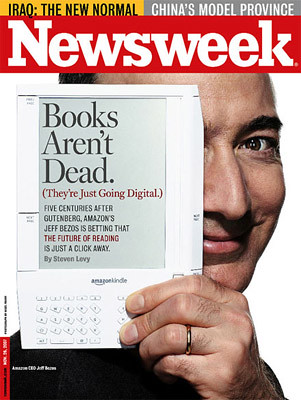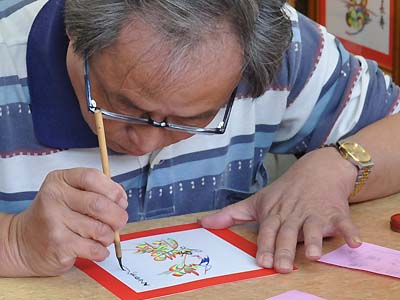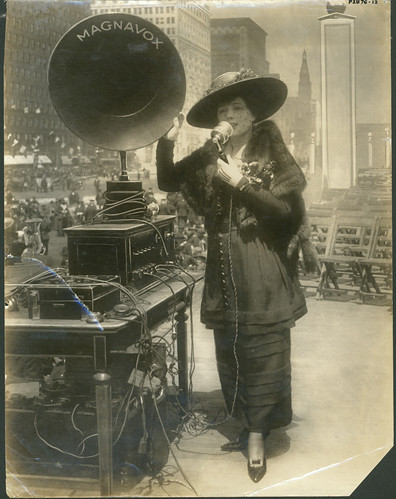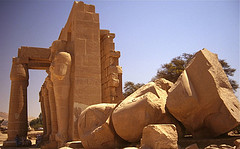Posts from — September 2009
Ozy
One of my first memories of text as something interesting and powerful came from what I at first thought was a ‘dumb’ exercise in public speaking. My Grade 9 English teacher, an Englishman with a blue nose that we suspected was the result of a fondness for pints, required that we memorize and recite a short poem. He offered to help us choose something suitable, and in my case, suggested Shelley’s Ozymandias. As I read it over and over to memorize it, a funny thing happened: I started to like it, I started to appreciate its irony and world weariness. I recited it flawlessly, and can still remember it to this day (though, I admit, I looked it up online to check my memory before posting it below).
I met a traveller from an antique land
Who said: “Two vast and trunkless legs of stone
Stand in the desert. Near them on the sand,
Half sunk, a shattered visage lies, whose frown
And wrinkled lip and sneer of cold command
Tell that its sculptor well those passions read
Which yet survive, stamped on these lifeless things,
The hand that mocked them and the heart that fed.
And on the pedestal these words appear:
`My name is Ozymandias, King of Kings:
Look on my works, ye mighty, and despair!’
Nothing beside remains. Round the decay
Of that colossal wreck, boundless and bare,
The lone and level sands stretch far away”.
–Percy Bysshe Shelley
September 20, 2009 2 Comments
The future of reading?

ebooks kindle amazon, originally uploaded by libraryman.
I chose this image because it features the Kindle (a digital book reader) which combines two of the key preoccupations of the course: text and technology. Discussions about the Kindle were briefly the rage among technophiles at my school, until it became apparent that, at least initially, the device would only be available in the U.S.
I’m Phil, a teacher-librarian and journalism teacher at Centennial School in Coquitlam, B.C. I’m in my 10th year as full-time secondary teacher, after seven years in the Canadian newspaper business. My last newspaper job was working as a copy editor at the Toronto Star. I was born in Vancouver and raised in the Okanagan, so it didn’t take long before the desire to come home set in. I had moved to Ottawa to do a master’s in journalism at Carleton, and it was there, working as a TA in Journalism 100, that I started thinking about teaching as a career. A bleak Toronto winter sealed the deal. After earning my BEd at UBC, I started teaching English and journalism. At Centennial, the teacher-librarian asked if I would be interested in taking a library block to help with Internet and digital (then CD-based) resources, and in the years that followed I slowly picked up library blocks and dropped the English classes. I wasn’t too interested in pursuing an MEd in teacher-librarianship until recently when it became apparent that the role of technology was being more closely examined by TLs. I’m an early adopter, but also a skeptic. Technology is costly for schools and many of its affordances and non-monetary costs are poorly understood. As Postman pointed out in the Technopoly excerpt (which I confess I read from my print copy rather than the PDF), there are costs as well as benefits in all technologies. It seems the school community is populated with technophiles and technophobes, and an insufficient number of people willing to inhabit the murkier middle ground. This will by the final course in my program and I am looking forward to it. However, I was waitlisted and just given access last week, so my first task is to catch up with the rest of the class!
September 20, 2009 No Comments
My reflection
I love looking at the diverse collection of photos and submissions on this site! I find it fascinating how different each photo is, yet each still captures an aspect of communication through orality, text, and/or technology, many in ways I had never thought of. I have appreciated the insights and comments from my peers. As I read through Ong’s, “Orality and Literacy” I have pondered how our comments and posts would differ if we were all together discussing these topics face-to-face. I have found that when posting to the blog site, I usually just sit down and begin typing what comes to my mind, in a style more similar to how I would speak. In this way I feel that this weblog allows for such a high level of creativity by offering a comfortable and accepting (and perhaps more informal) learning community. I do find the threading aspect of the discussions within Vista a visually more pleasing method of connecting our discussions. However when writing a discussion to be posted in Vista I tend to rewrite and rework my passage much more than I do when posting a blog! I enjoy and appreciate the variety of methods (Weblog, Vista, Wiki) for sharing our thoughts and I have and would continue to use these methods with my students. I have found that my students love seeing their work, comments, projects, artwork (anything!) posted on a blog site for everyone to see.
September 20, 2009 No Comments
Classroom Writing – Korpan Intro

Luhrs Library, originally uploaded by ShipLibrary.
Trying to catch up on Module 1. Sorry for the late post.
I chose this photo as it represents my reality with text and technology in the classroom. We have classroom labs of 15 computers, as well as a mobile wireless cart in our schools. One of the constant issues is the appropriate and effective integration of information technology into the curriculum and instructional practises.
I am currently working in my fifth year as a K-12 Special Assignment teacher for St. Clair Catholic DSB in Southern Ontario. My previous classroom experience has been mostly at the grade 7/8 level. This is my 4th course in the MET program.
Among the many hats I wear in this role, I work closely with the District Literacy and Numeracy team of teachers in my board, as well e-Learning. My interest in this course stems from bridging that digital divide to transform teaching practises to include more digital literacies and electronic forms.
Sharon Korpan
September 20, 2009 No Comments
Module 1 Reflection: Collecting People, Collecting Knowledge
Last semester for ETEC*565, I created blog which housed my personal learning journey for the course. This was my first foray into blogging. From this experience I learned how important it is to regularly contribute to a blog in order to fully engage with the subject matter. As well I ended up with a nice snapshot of my growth over the course of the semester. Our Community Weblog takes a different approach in that all of us post to the same blog – a shift from building individual knowledge to creating distributed knowledge, built on collaborative and network literacies. This exposes all of us to diverse perspectives allowing each of us to construct new understandings of the topics raised. As our communal writing space archives all contributions, we will also be able to reflect back on our collaborative journey by the end of the course.
Postman (1992) states “new technologies alter the structure of our interests: the things we think about. They alter the character of our symbols: the things we think with. And they alter the nature of community: the arena in which thoughts develop” (p. 20). With our Community Weblog environment we can create a knowledge database with a structure that allows for spontaneity, the ability to link back to original sources and the ability to embed images and video to support our writings. The disorientating nature of the navigation differs so greatly from the linear ways of learning most of us are familiar with, thus it can be frustrating for many to determine where to start or how to proceed with participating.
On the other hand, the blog environment encourages us to push our understandings beyond text-to-text communication to create dynamic and flexible interpretations that we can continue to build on. Unlike our discussion forums, ideas are much more dispersed and are organized only by the tags and categories the participants employ. This allows for each individual to create their own connections and take responsibility for their own learning. The comments feature allows us to make connections and begin to tie ideas together. We all are responsible for the success of our shared space and thus participation will be essential throughout the semester for this to be a truly valuable experience.
On that note, with two sections contributing to the blog the amount of posts to-date is overwhelming – almost too many to keep track of. The search, tagging and category functions are absolutely key to being able to find information – somewhat of an organized chaos!
Karen Stephenson states that “experience has long been considered the best teacher of knowledge. Since we cannot experience everything, other people’s experiences, and hence other people, become the surrogate for knowledge. ‘I store my knowledge in my friends’ is an axiom for collecting knowledge through collecting people” (Stephenson, in Siemens, 2004, An Alternative Theory, para.1). As we all have different skills sets, experiences and knowledge we bring to the table, as a collective we are much stronger than we are on our own. Our weblog then becomes yet another link of our personal learning networks. It will be truly interesting to see how this space evolves over time.
References
Postman, N. (1992). Technopoly: The surrender of culture to technology. New York: Vintage Books.
Siemens, G. (2004). Connectivism: A learning theory for the digital age. Retrieved September 20, 2009, from http://www.elearnspace.org/Articles/connectivism.htm
September 20, 2009 No Comments
Reflections
I am impressed with the creativity of my fellow students and the openness of the professors to allow this freedom. As someone who is not very creative (!!!) I am learning that there is a great many ways to express ones ideas. I appreciate the effort that each person has gone into to post unique and interesting descriptions. In terms of using the community weblog as a learning platform I believe it lends itself to a more creative and open learning space. I do like that the entries are posted by date and tags and it is up to the person creating the post to ensure that they make the entry correctly. It will be fun seeing how this all develops.
Sarah
September 20, 2009 No Comments
Module 1 Reflections
As we move from an industrial based society to an information based society, the role of text and technology continues to metamorphosize. (I think I just invented a word). Simple perceptions of what comprises text are no longer valid. Postman refers to a principle of technological change: the collision of two world views—text and television (p.16). One can perceive a collision simply within the world of text as emerging technologies allow for the display of text in heretofore unimagined formats (hypertext, digital readers, sixth sense). Particularly in regards to education, bounded by a dependence upon traditional codex, the value of “the unreal knowledge acquired through the written word” (Postman, p. 17) varies.
How important is handwriting in an age of electronic print formats?( http://www.msnbc.msn.com/id/32925695/ns/us_news-education/?GT1=43001 )
While Postman emphasizes the group learning, cooperation and social responsibility prominent in orality and contrasts this with the introspection and isolation of the printed word, the union of emerging technologies with text have resulted in new print spaces with all the elements of oral communication: wikis, blogs, hypermedia formats, etc. As fellow classmates have mentioned, we are a post-print society adapting to new formats of text representation. How will this affect the value of knowledge and which formats of knowledge are valued?
References
Postman, N. (1992). Technopoly: The surrender of culture to technology. New York: Vintage Books.
September 19, 2009 No Comments
Technology
My thoughts on technology…
References:
Suction Tool. Digital image. Flickr. 1 July 2007. Web. 16 Sept. 2009. .
technology. (2009). In Merriam-Webster Online Dictionary.
Retrieved September 16, 2009, from http://www.merriam-webster.com/dictionary/technology
September 19, 2009 No Comments
Text
I created a voicethread to incorporate my thoughts on text.
References
text. (2009). In Merriam-Webster Online Dictionary.
Retrieved September 16, 2009, from http://www.merriam-webster.com/dictionary/text
Wiktprintable without text.svg. Digital image. Wikimedia Commons. 27 Mar. 2009. Web. 16 Sept. 2009. .
September 19, 2009 No Comments
Module 1 Reflections
First of all, I am very impressed with our knowledge community! I’ve read several postings, commented on a few and generally felt inspired by my classmates. The theories of distributed knowledge and constructivism are at play in our community. By sharing their insights, my classmates have provided me with fresh perspectives on difficult issues. I think the community weblog and our introductory web project are interesting and valuable ways to begin a course focused on “the changing spaces of reading and writing”. A community blog is exciting, challenging (eek, posting an avatar and resizing it!) and effective. I actually started a Class Blogmeister based on this format for my grade four students!
My feelings toward the intentional disorientation on this weblog is one of relief. I like the fact I have to sit back and think about how to connect posts and how to use the available tools to make the most of linking thoughts together (tag searches, searching by name…etc). I think some benefits of disorientation are forcing a student to challenge old thought patterns, reaching more learners (like me!) and displaying/creating knowledge in a new way to create new learning connections. One disadvantage may be some students may feel frustrated or intimidated navigating such an environment and thus, be less motivated to engage in the learning oportunities.
Defining text and technology at the beginning of my MET studies would have been as simple as looking them up in the dictionary. However, given the opportunity to analyze the terms and engage in discussion about them (and to reacquaint myself with the history of Webster’s Dictionary) simplicity is now out the window.
Some of you may have noticed I posted my concept of text and technology a little early. I was not devaluing the importance of our class discussions, but instead I posted early simply because I printed out the module and mixed up the pages. I posted my terms before my introduction!
Now, reflecting on this, I see how some text for me must be in print, in my hands, when it’s “important”. Yet, I also see how our digital module had the same important text organized in a more efficient manner. I discussed the concept of printed materials with several classmates and was relieved to find that other students behaved the same way.
I also discussed anticipated changes in relation to text and technology. The emergence of YouTube as a return to orality, the concept of hyperlinking as an emergent textual form and issues surrounding the educational acceptance of digital literacy. Postman (1992) reminds us that there is a power struggle inherent in any society that adapts technology. However, I now feel philosophically closer to O’Donnell and Engell in “Papyrus to Cyberspace”, from the Cambridge Forum(1999) broadcast, on the grounds of finding a societal balance for the costs and benefits of new technology. For example, I now see YouTube as democratizing and balanced as it does not seek to replace text as it provides people a space to speak from.
At the end of Module 1, I’d like to return to our modular reading (in Module 1 of 540), where we are reminded that we are in a “post-print” society. I love the concept of “post-print”, whether I read it or say it aloud! “I am a member of a post-print society”, very impressive. I now see how writing itself is a technology and I’m excited to learn how “post-print” society adapts to our socially created drive for text representation. Clearly we’re adapting as I’m engaged in a rich discussion for my e-learning class using a community weblog! Erin
References
Cambridge Forum. (1999). From Papyrus to Cyberspace. Available from ETEC 540 Module 1.
Postman, N. (1992). Technopoly: The surrender of culture to technology. New York: Vintage Books.
September 19, 2009 2 Comments
The Art of Text

Coming from a design background, I have come to see text as an art form that is often manipulated as content or as part of a layout and for me, that is usually how I intermingle text with technology. Text is no longer a static form but it can also be animated. Looking back at the origins of text in its more static form, some examples of text as an artistic, symbolic form is its use in hieroglyphs and asian characters. Technology works to, in some form, mechanize the text through writing tools, printers and other text-making tools.
One mingling of text and technology that came to mind is the use of calligraphic tools not just for communication but as an art form. In Asia, the calligraphic brush was more widely used in the past to paint characters in languages. When painted, the symbols have flowing strokes and lines, with some strokes more emphasized than others. Today, those same characters in print have been “mechanized” and converted into harsh lines and strokes that are even throughout. The same can be said for handwriting.
What are the implications of text and technology today: How much have computers created a kind of convenience in the way we communicate and will handwritten texts still exist in the future? In the last 10 years alone, I think technology has done a great deal in changing the way we look at and learn how to use text using computers, cell phones and other, more advanced non-traditional devices.
Marjorie
September 18, 2009 2 Comments
David Berljawsky’s Refelctions.
I am impressed by the amount of material that has been posted on the weblog. Although I am aware (obviously) that this is an online project taken on by multiple students, the sheer amount of work that has been gathered in a short amount of time is nothing short of impressive. One can only imagine how a classroom of students would react to seeing a large amount their work online. One slight critique is that if I was new to blogs I might have had a difficult time navigating the site. I have read some extremely informative opinions on the nature of technology and text. I’ve noticed that there are many different and open ended views on the definition and I’ve enjoyed reading all of these varied opinions.
This is my first online course, and I feel that this activity was a wonderful introduction to me. Ironically, I think that I may have spent more time online in the forums and weblog than I may have actually spent in a regular class.
I’m unsure how to answer the question about my opinion of the structure of the existing web. It’s not perfect, but it is what we have and we need to use the positive aspects to our best ability. The entire communicative and collaborative nature of the web is what attracts me to it as an educator. Everyone is able to add their opinion and views to the web regardless of their technical expertise. This activity is a perfect example of how this is possible.
September 18, 2009 No Comments
Module 1 Reflections
I have enjoyed creating blog entries for the first module and reading my classmates’ entries. It’s surprising how many unique images people chose to represent the curriculum of Module 1. In the past, I have enjoyed creating bog entries for ETEC courses and think that they offer a great opportunity for me organize my thoughts, watch my progression through the course material, and learn from others. I also imagine how I could use the same means when I design elearning courses.
September 18, 2009 No Comments
Text/Tech:The World’s Fastest Text Message?

Upon browsing various sites for multimedia related to text and/or technology, I stumbled upon this video. Initially, I wanted to find two separate items with which I could create two separate entries, but this video provides a nice, although literal, juxtaposition of the two.
Text: What is it, exactly?
If I had been asked to define text 10, or even 5 years ago, I might have come up with something such as:
The words of something written; “there were more than a thousand words of text”; “they handed out the printed text of the mayor’s speech”;
the main body of a written work (as distinct from illustrations or footnotes etc.); “pictures made the text easier to understand”
(From: wordnetweb.princeton.edu/perl/webwn)
Today, I have a slightly different understanding of what text is. Having read several definitions and analyses of the origin of text, today I believe that text is or can be considered to be:
- A representation of meaning and language
- written word
- oral word
- represented through media such as video or sill image
- is a part of literacy
- authoritative or questionable
- dynamic rather than static
- uniquely human
As educators, our definition of text will impact our teaching. Is it acceptable, for example, for language arts students to create a video in place of writing am essay? Is it necessary that teachers ensure all forms of text are taught and practiced?
My response to this is that in B.C., we are able to do so. For example, the language arts curriculum, even at the elementary level, allows teachers to transcend the traditional boundaries put upon us by our former definitions of text and literacy. Although there are mandated curricular goals for reading, writing, viewing and representing, we are able to move beyond the pages of the classics, and forge ahead into new text (and new media) spaces.
Technology: From the Wheel to the Smart Phone
Technology, like text, has a complex definition, and similarly, if I had been asked 5 or 10 years ago to define technology, I probably would have said something about computers and telephones. I find that it is almost easier to preface the word technology with some sort of adjective that narrows it down: digital technology, information technology, computer technology, assistive technology, medical technology and the like.
Princeton’s Wordnetweb defines technology as, “the practical application of science to commerce or industry” (wordnetweb.princeton.edu/perl/webwn). My “newish” Oxford dictionary of English has a similar definition. It is intriguing to me that a word that has so many varying connotations might have such a simplistic definition. This is another reason why I chose to present my thoughts on both text and technology in the same post.
The Text/Technology Connection
In the video at the beginning of this post, we are able to see very clearly, and as I mentioned previously, quite literally, one link between text and technology. We use technology every day to create text, whether it is “texting” on a cell phone, speaking to a friend on Skype, writing a grocery list with a pencil, or typing an essay on the computer.
As Ong (1982) proposes, “writing (and especially alphabetic writing) is a technology, calling for the use of tools and other equipment…[and] by contrast with natural oral speech, writing is completely artificial” (p. 80-81). Upon looking back at the above list of possible daily “texts”, and thinking of other possibilities, labelling writing itself as a technology makes good sense.
As we continue on our journey through “the changing spaces of reading and writing”, I anticipate feeling the need to revise and update my current thoughts on text and technology in the near future. I suppose that is the beauty of a dynamic text space such as a weblog–it can always be a work in progress.
Cheers,
Stephanie
September 18, 2009 No Comments
Text : A poem by Rumi (1207-1273)
“That calligrapher wrote three different texts
The first text could be read by him and others
The second text could only be read by him, not by others
The third text could neither be read by him, nor by others
I am the third text”
September 17, 2009 No Comments
Technology
Initially I thought technology was all about tools- things to digs holes with- write things with- it was all about things. I believe that technology is all about creating. We use technology to create and display our ideas. Man develops technology to help solve problems sometimes, but not always. Sometimes technology is developed for the sheer purpose of creating something- afterall who really needs an electric back scratcher!! Technology is tools for digging holes, but it is also text for displaying thoughts and feelings, it is music, and it is art. Martin Heidegger ( 1977) suggests that technology is the revealing as art is revealing- I think he is posing the question -” Is art and technology one and the same?” and I think the answer to this is yes.
September 17, 2009 No Comments
Module 1/Weblog reflections
This module has been a great introduction to the changing world of text and technology. I have been struck by all the different types of images that we (as a class) were able to find on Flick.r and how they all seemed to relate to technology and its impact on writing and literacy.
I like the collective space and can see how this experience will help when I introduce blogging to my students in the future. That being said, I like being able to post my musings to the forum within the Vista platform. I find it’s much easier to read and respond to others.
September 17, 2009 1 Comment
Fritzi Scheff demonstrating Magnavox for Fifth Liberty Loan in New York City, 1895

Fritzi Scheff demonstrating Magnavox for Fifth Liberty Loan in New York City, 1895, originally uploaded by Powerhouse Museum Collection.
“New” technology is being shown off here in the photo.
I selected a musical theme since music is termed the “universal language” and technology has provided a way for us to weave music into our life in a way that had never been possible. With high capacity portable players, we can immerse ourselves in our favourite tunes anywhere anytime. it is posited that so many songs have now been penned that the combinations of notes for a musical flow have been exhausted if one considers songs from all ages, all places. That is amazing to me.
The technology of music has blossomed in a way that allows us to hear a beautiful symphony without travel, the chants and drums of African and other world music at the flip of a key, and to record our own music using simple add-on technology for our computers.
Current home studio products exceed the multitrack capacities of the recording studios used by the Beatles. The proliferation of online distribution channels has revolutionized distribution.
The whole system surrounding music has significantly changed in the short history of recording. The sophistication of the tools as well. That is what appears to me to be the meaning of technology–both system and tools. The dictionary definitions I reviewed in OED and elsewhere are interesting from an etymologic perspective indeed but for simplicity, system and tools describes technology surrounding music.
I still like analog! Best wishes, Kathleen
September 17, 2009 No Comments
Nailing Down Technology

“Technology” is almost as broad of a term as “text,” however; in the context of ETEC540, it’s a little easier to nail down. My new understanding of these two concepts is that they clearly have something fundamental in common. They are clearly both SYSTEMS. Examining them together has helped me see this significant overlap. Could we have “text” without “technology?” No, because text is a technology of communication. Could we have “technology” without “text?”
September 17, 2009 1 Comment
French Text Soup

If you boil down all the definitions of “text” on medium heat and stirring often, what you get is essentially “language” soup. Like an onion, both concepts can be deeply layered and infinitely complex, but both have the same general purpose. Okay, so what is language then? Well, it’s a system of communication. And what’s the general purpose of an onion?? Well, to give us bad breath and make us cry.
September 17, 2009 No Comments


